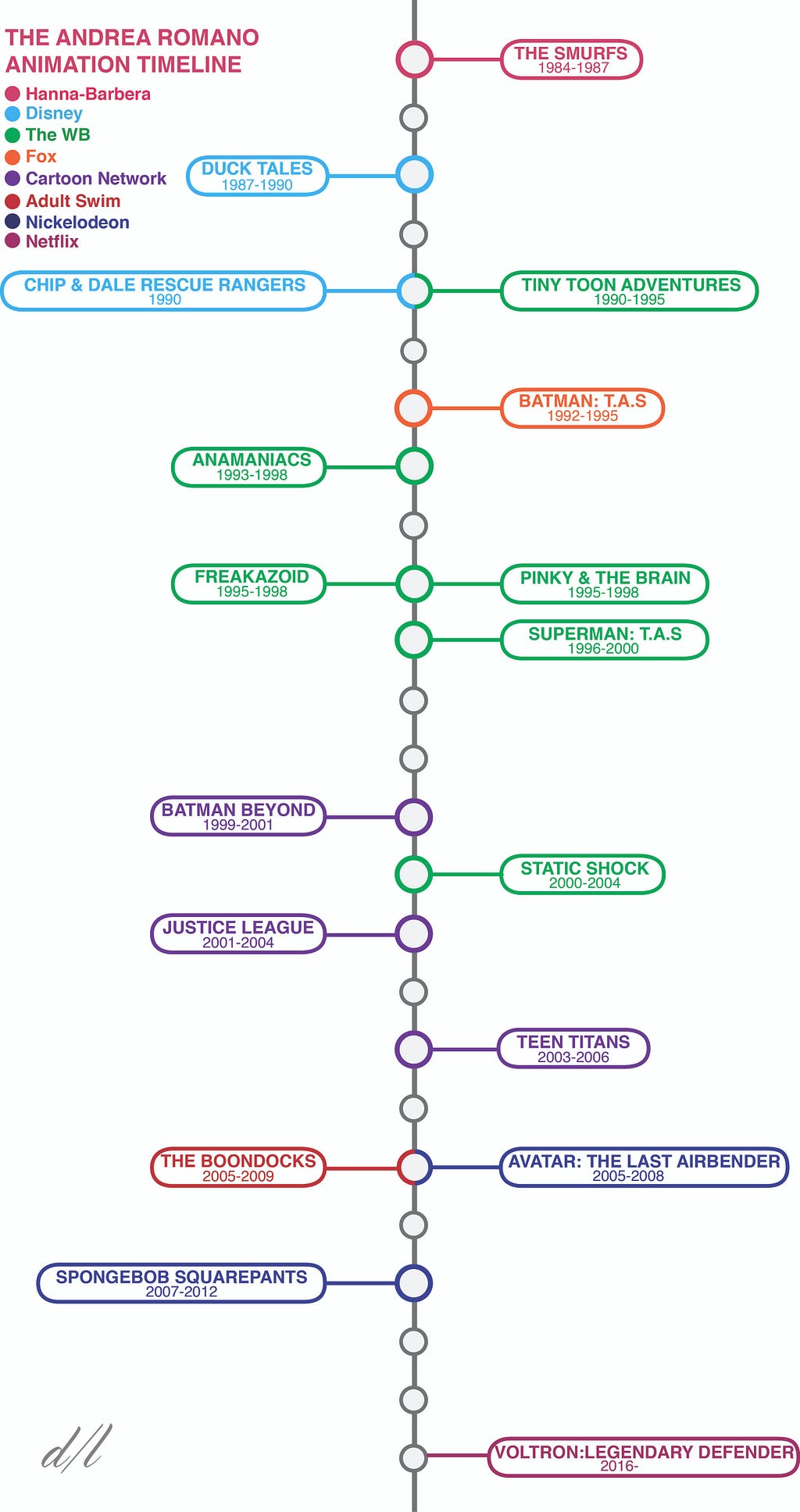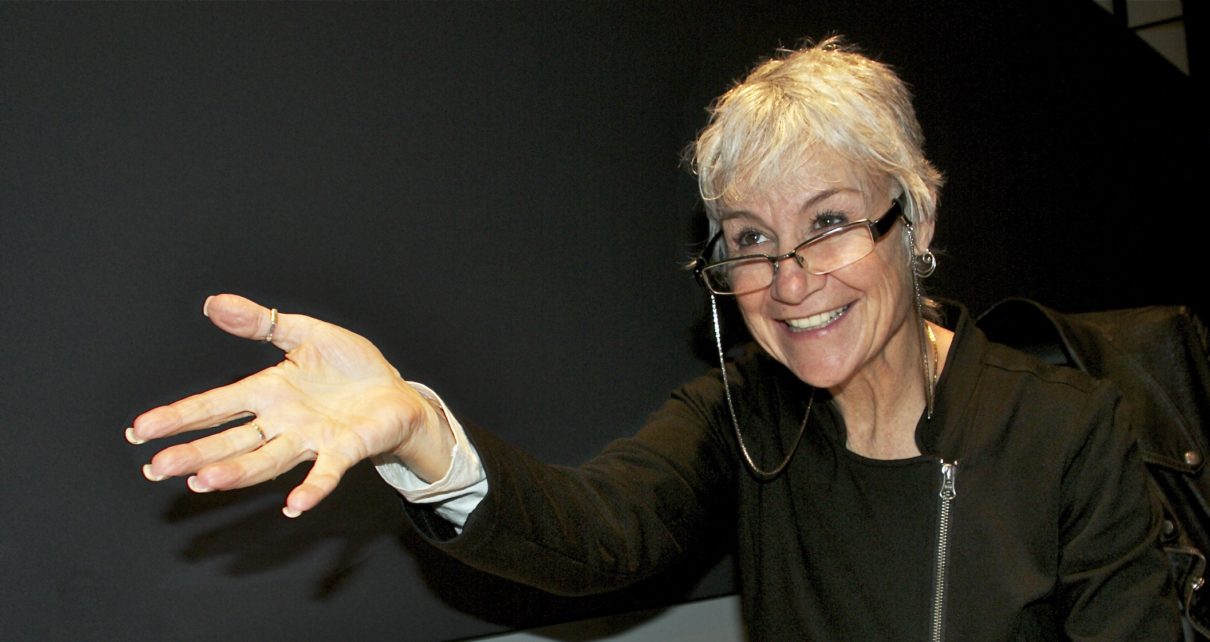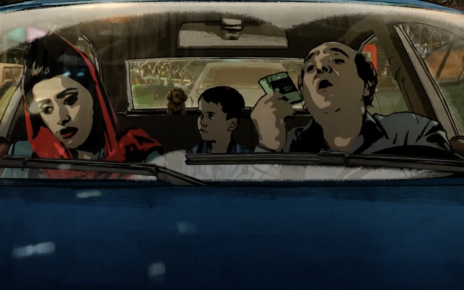Andrea Romano begins every work day the same way.
Right upon waking at 4:00 a.m., Romano checks her email, making sure she can do everything she has scheduled. She makes sure she has time baked in to take every call. Between 4 a.m. and 8 a.m., she eats breakfast and does prep work on scripts — reading for tone, working through direction in her head, making notes. By 9 a.m., she’s at the studio, recording her first cartoon show of the day. After a few hours, she gets lunch. By 1 p.m., she’s at another studio until the end of the day, working on another show or film for several hours. By 9 p.m. her day is over.
“I used to say yes to everything,” the legendary voice and casting director admits. “As I’ve gotten older, I’ve learned I can’t do that anymore.”
Romano, who turns 61 today, is the most respected voice-over director in Hollywood animation. Her resume reads like a one-to-one match of some of the best-known children’s cartoons of the past 30 years: The Smurfs, DuckTales, Batman: The Animated Series, Animaniacs, Pinky and the Brain, SpongeBob SquarePants, Avatar: The Last Airbender, The Boondocks, a handful of turns as a voice actor herself, and around 200 other credits—most recently, the latest iteration of Teenage Mutant Ninja Turtles, some work on the Ratchet & Clank film, and Netflix’s Voltron reboot.
Romano has cultivated a reputation as one of her industry’s hardest workers, committed to finding the best actors for roles and pushing them to give performances that rise to canonical stature. Now, after 31 years, she’s begun winding herself down. It’s been a long time coming.
Romano speaks very, very quickly, and with precise diction. She calls it a byproduct of coming from a large East Coast family, but she always knew she wanted to work in the entertainment industry in some capacity. “I don’t know if you can tell, but I have a lot of energy,” she says, in the manner of someone who’s probably repeated the line more than once.
She first funneled that energy into New York City theater gigs in the 1970s before moving to San Diego, where she worked as an agent before getting her big break: a job as a casting director at Hanna-Barbera Productions, Inc. Hanna-Barbera proved a major stepping stone, putting her to work on shows like The Jetsons and The Smurfs and introducing her to contemporaries like Ginny McSwain, who would go on to hold a distinguished voice directing career herself. Their boss there was veteran voice director, Gordon Hunt.
If you liked this story, sign up for our newsletter.
“He taught us everything,” she says of Hunt, the mentor who first taught her the importance of making sure actors in the recording studio were kept as relaxed as possible.
Romano points to two of Hunt’s lessons as being particularly resonant:
Above all, “it’s about acting, acting, acting,” she says. A majority of popular audiences might still not get it, but voice acting — especially in cartoons — is a dynamic and physically demanding marathon. Mark Hamill, best known as Luke Skywalker of Star Wars but revered in the cartoon world for voicing the Joker from Batman: The Animated Series, was known for standing in the booth and gesticulating wildly, physically acting and going as over-the-top as possible. Romano not only directed him, but was responsible for his second career as a voice actor in the first place—and it’s on the voice director, she says, to extract that kind of performance from the actor as best she can. That dovetails with another lesson she learned from Hunt:
“You have to bring the energy,” Romano says. “And you have to match the energy the actors bring.”
Of course, that energy is exactly what Romano is known for. In the 1990s, her previous work at Hanna-Barbera and Tiny Toon Adventures, and DuckTales, led her to projects like Batman and others under the Warner Bros. Animation stable: Pinky and the Brain, Animaniacs, Superman: The Animated Series, Static Shock, Batman Beyond, and more. She’d often work on shows simultaneously, often on weekends, and always in a freelance capacity. She wasn’t just putting in hours, either, but directly engaging with her actors, encouraging them to more powerful, more expansive performances. If, during the process, they blew through the roof, she could always bring them back.

“I’m always trying to get actors to give me more,” Romano stresses. “More.”
“More” can often feel like too much for some actors—especially if they’re used to acting for the screen and not the stage, Romano says. She saw this when working with Michael Emerson, the actor behind LOST’s cold and calculating Ben Linus, when he voiced the Joker in the two-part animated adaptation of Batman: The Dark Knight Returns. She’d wanted to work with him for years, and after some coaxing, Emerson, who is not a trained voice actor, impressed her with his performance.
“I’ll always hear Mark Hamill as the Joker or Kevin Conroy as Batman,” she says. “But Michael Emerson did something different with his Joker.”
And yet…
“I was so surprised,” she says. “At the end of his session, Michael Emerson turned to me and told me: ‘That was the hardest thing I’ve ever done.’”
This has happened to Romano — who has worked with plenty of famous screen and stage actors, including William H. Macy and Dakota Fanning— a few times.
“I would love to work with Tom Hanks,” she says, calling to mind a Hollywood function in the early aughts where she’d met the man behind the voice of Toy Story’s Woody. He complained about the number of takes he had to sit through while voice acting, and Romano scoffed. “You don’t have to do it 30 times,” she insists, not with her instincts and experience behind the wheel.
For what it’s worth, the people who’ve worked with her tend to agree.
“Boy, is she efficient,” Justin Michael, host of Batman: The Animated Podcast tells The Dot and Line. He’s had her on his show and taken voice-acting workshops with her, and can confirm: “She says more in a minute than anyone else I’ve ever met. And she’s very kind.”
“You make these choices you would never do if you were doing a live-action role,” says Hamill, on a DVD special for Batman: The Animated Series.
“She has a real love for actors,” says Conroy, whom Romano cast as Batman, and whose rich basso rumble gave life to what many Batman fans believe is the quintessential representation of the character on screen. “She always insists on everyone being together. The bookings for all of Batman: The Animated Series were done as radio plays where she’d have all the cast in a studio together—and as a result, those recordings were phenomenal.”
Romano’s passion is infectious, and as a result, her actors tend to become something close to family. Exactly one year ago, Rob Paulsen, who voiced Yakko on Animaniacs and Pinky on Pinky and Brain, tweeted a happy birthday selfie he took with her and fellow voice actor Fred Tatasciore:
Happy Birthday to voice director extraordinaire, Andrea Romano! With Fred Tatasciore. Love this girl.
Almost a year later, Paulsen joined Conroy on stage in October at the International Family Film Festival to present Romano with the Friz Award for Excellence in Animation. Conroy expanded on how deeply he cared for her, and he and Paulsen broke into a “Pinky and the Bat” bit — video of which is almost criminally not available online — in which each voiced his own iconic role before handing her the award.
“Gee, Batman. What are we going to do tonight?” Paulsen asked.
“Same thing we do every night, Pinky,” Conroy said, as they presented her with the award.
To this day, Romano considers Paulsen one of the funniest people she’s ever met and instrumental, in his role as de facto Animaniacs leader Yakko, in making that show’s often-improvised, very adult jokes land. Likewise, Conroy is a dear friend. So when she learned she’d be receiving the award, she selected the two of them to present it to her. “I wanted to pick people whose careers I had touched,” she says.
And touched they were—as was she. “I still point to the day we cast Kevin Conroy as Batman,” she says, when asked to name one of the highlights of her career.

Batman: The Animated Series, Romano’s first—but far from last—dive into the world of capes and cowls, represented a unique challenge. The cartoon offered a serious take on the canonical hero, which had never been done before, and told its comic-book stories with a sense of gravitas and ambition that had more in common with 1940s cinema than its early-1990s cartoon contemporaries. Finding the perfect lead to anchor the show was essential, and she listened to well over 500 tapes and more than 150 auditions to find the perfect voice. Then she heard Conroy audition, on one of the last days of callbacks, and knew right away that he was perfect.
“And now you read a review for a live-action [Batman] feature and they all say, why don’t they listen to the voice of Kevin Conroy?” as she put it to CBR. “And I’m so flattered, and Kevin is so flattered, that our Batman series is referenced as one of the top Batman productions ever.”
Another highlight? Directing Spielberg—yeah, that one—in her studio.
“I turned to the producers and squealed, ‘I’m directing Steven Spielberg,’” she recalls with a sharp inhale. (Spielberg produced Tiny Toon Adventures, Animaniacs, and several other ’90s shows she worked on.) “I’m not easily intimidated,” she insists. Nonetheless, she added, “a lot of people get to work with Spielberg. Not everyone gets to direct him.”
The 2000s saw Romano work on both direct-to-video films and even more animated series for different studios and different types of shows: finite series like Avatar: The Last Airbender (“They know every detail of their show,” she praises); superhero shows and films from the DC Comics stable (“I probably know more about superheroes than any 60-year-old woman in the world,” she jokes); and limited-episode orders for Netflix shows like Voltron: Legendary Defender (“It [used to be] hard to do serial cartoons because you had to deliver episodes by a specific date,” she notes, adding that casting and directing serials is actually easier on her schedule in the age of Peak Content).
In other words, for now, she’s still hard at work— even if she’s not exactly juggling a half-dozen projects at once and putting in the weekend hours all the time like she used to. When she announced last year that she would retire at 65, “I was worried people wouldn’t want to hire me, because many shows want to go on for more than five years.”
Yet when she looked at her inbox, Romano says, “[the reaction] was the opposite.” She found herself flooded with pleading notes: “‘But we haven’t worked together yet!’”
Romano, for her part, is flattered, but resolute. As Hunt mentored her, she’s mentoring another woman to carry on her voice-directing legacy—and, in a way, to take care of the actors she’s worked with for her entire career. (She won’t release that woman’s name until she feels she’s “ready.”) And once she hits 65, she plans to spend her final years with her husband, the Brazilian cartoonist Rogerio Nogueira, on a sítio—like a farm, but more relaxing and bucolic—nestled in the mountains between São Paulo and Rio de Janeiro, near Our Lady of Aparecida. At 61, she says she’s ready to learn Portuguese.
“A lot of people want to retire with at least 5 years left,” she says, practical where others might be morbid. “I want to retire with 10.”
Still, if you’ve been paying attention, it’s not hard to imagine what line her collaborators might echo in vociferous rebuttal:
“Give me more. More.”
If you liked this story, sign up for our newsletter.
Thanks for reading The Dot and Line, where we talk about animation of all kinds. Don’t forget to ❤ this article and follow us on Twitter and Facebook.





